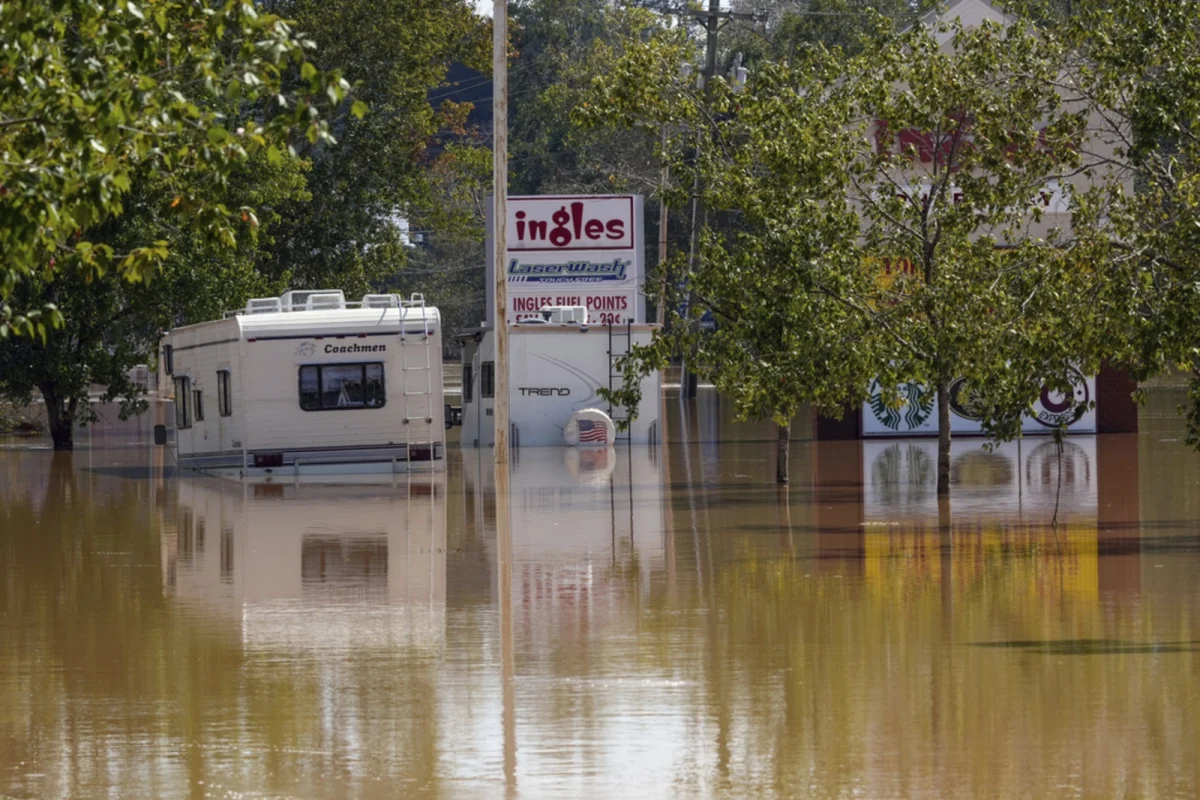This past week The Nubian Message sat down with Adam Wampler, an NC State Alum and Environmental Technician, to discuss the effects of Hurricane Helene in Western North Carolina and its contribution to climate change.
From landslides to increased sedimentation, the aftermath of Helene reveals the fragile balance between nature and human resilience in the changing climate.
Having grown up in Western North Carolina, Wampler explained how big storms and hurricanes never really made it up to the mountain region. Wampler explained that it was “the intensification experience of the rapid warming within the Gulf of Mexico off the coast of Florida meant that by the time it was hitting the mountains, it was in places still a hurricane. There were hurricane-force winds reported not too far away from where I live and part of the biggest issue of what caused the massive destruction we’re seeing is climate change itself. When you have these massive storm events intensified by abnormal climatic conditions, you have unpredictable outcomes.”
When asked what distinguished Hurricane Helene from other storms in recent years, Wampler explained, “Climate change has a huge effect on this. Some folks remember Hurricane Fred which also hit my hometown two years ago. It fully wiped out many communities. One of the mayors of our town was preparing for this hurricane with the idea of Fred in mind, as Fred had completely submerged their downtown. Even still, those preparations were not enough. Storms of this size should not be happening this frequently without manmade climate change.”
According to Wampler, hurricane season and hurricanes will see a change in duration very soon. Wampler explains, “The temperatures within the Gulf of Mexico and the Atlantic are rising and that is causing hurricane seasons to start a bit earlier and end a bit later.”
“We’re also seeing more rapid and longer-term intensification and slowing down intensification. Warmer ocean temperatures cause more powerful hurricanes and what we’re seeing is climate change is consistently warmer temperatures, especially in places like the Gulf of Mexico that traditionally have a lot of hurricane and tropical storm activity. Climate change itself causes these, especially causing strength and duration to increase,” Wampler said.
When explaining the role that the Gulf has plays in storms like Helene, Wampler said, “You have the Gulf Stream and the Gulf Current. The Gulf Current goes up the Eastern seaboard from around the Gulf of Mexico all the way up and around. A lot of hurricanes get caught in that and that will direct its path. Because of its weakening, we see more hurricanes being able to get inland. Those paths are not so much changing, but the more devastating ones, the ones that are inland are happening more often. You normally see it prepared for on the coast, but it happened in the mountains with massive flooding and winds and that necessitates the massive response we’re seeing.”
When asked about the long-term environmental consequences and predictions for areas hit by Helene, Wampler said, “A big issue we’re seeing right now is the movement of land, silt and sediments off the mountain slips causing major impacts. I spent two days after the aftermath of Hurricane Helene clearing out a landslide site near my house. A stream had roaded down and caused a landslide, a very small one luckily enough, that had filled culverts and rerouted over a mountain road that was not state-maintained. Because of that, those who private-owned that road had to go out with shovels, and are going to have to get some heavy equipment, to clear out culverts just to get the stream flowing through.”
When discussing the environmental impact Wampler described the situation as “is even worse.”
“That stream-changing path is something we would expect, it might be anticipated for a natural environment. Any of the areas downstream of that shift caused by landslides is going to have a massive loss in quality of life for the critters living there. There are fish, salamanders, and crawfish that rely on consistent water that aren’t getting it for multiple days, even despite the massive rains. What would’ve been a generally good thing for providing water quality has turned into a really dangerous thing because it changed the stream path,” Wampler explained
Wampler discussed the high deposition rate in the region, “You also have worries about sedimentation. These cause impacts to the macroinvertebrates, which are small bugs that live in the creeks. They rely on having very clear water and low sediment to just survive. So the high sedimentation rate we’re going to be seeing thanks to the hurricane is going to cause a lot of them to die, which can have great buildup effects throughout the ecosystem. Pretty much everything in the creeks relies on those little critters that are going to die because of these sediments we’re seeing.”
He also explained how people play a role in this as well, “The more paved area you have, the more runoff you’re going to have. That can not only carry with it the sediments but also the pollutants from cars and nonpoint source stuff that would get in and make the water toxic. There are going to be major ecosystem impacts from streams that were once a very muddy bottom providing an important habitat to become a completely rock bottom, which provides great habitat for some creatures, but you need to have that variety. That’s something we’re just not going to see for a long time. It’s going to take years for the natural ecosystems to recover from the impacts we’re seeing from Helene.”
The impact that Helene left on Western North Carolinas electricity is going to increase some of the carbon footprint from individual power generation. While there are some arguments that the reduction in energy usage, given just the loss of power to these areas, could have short-term impacts on carbon availability. It’s going to have long-term impacts on the number of cars that have to be mobilized from long distances of crews from all over the United States in the Western parts of North Carolina providing support.
Wampler even explained how the influx of machinery in the area has also left an impact, “These are vehicles that need to have these high-powered engines that can only be run on high-carbon fuels, and those impacts of the long-distance transit to get to western North Carolina, along with the hours of work and movement that they’re going to need, are going to cause a greater carbon footprint within the region.”
Wampler also discussed the impact Helene left on the deforestation of the region, “We also have some of the reduction of forest lands. Lots of trees were knocked down by the storm. We’re going to have a lot more that are going to be storm-damaged and are going to have to be taken down by tree companies to protect property and life. And you have some areas being completely buried under sediment that’s going to cause issues if those plants are not able to regrow.”
Wampler explains that anyone who would like to help the people of Western NC, donate to the NCCF Disaster Relief Fund and local counties’ preferred organizations like United Way, Mountain Projects and the Asheville Tool Library. These efforts are needed. As much as tourism is something our economy relies on, there are barely to not enough resources for the locals already, so please do not travel to the region.







